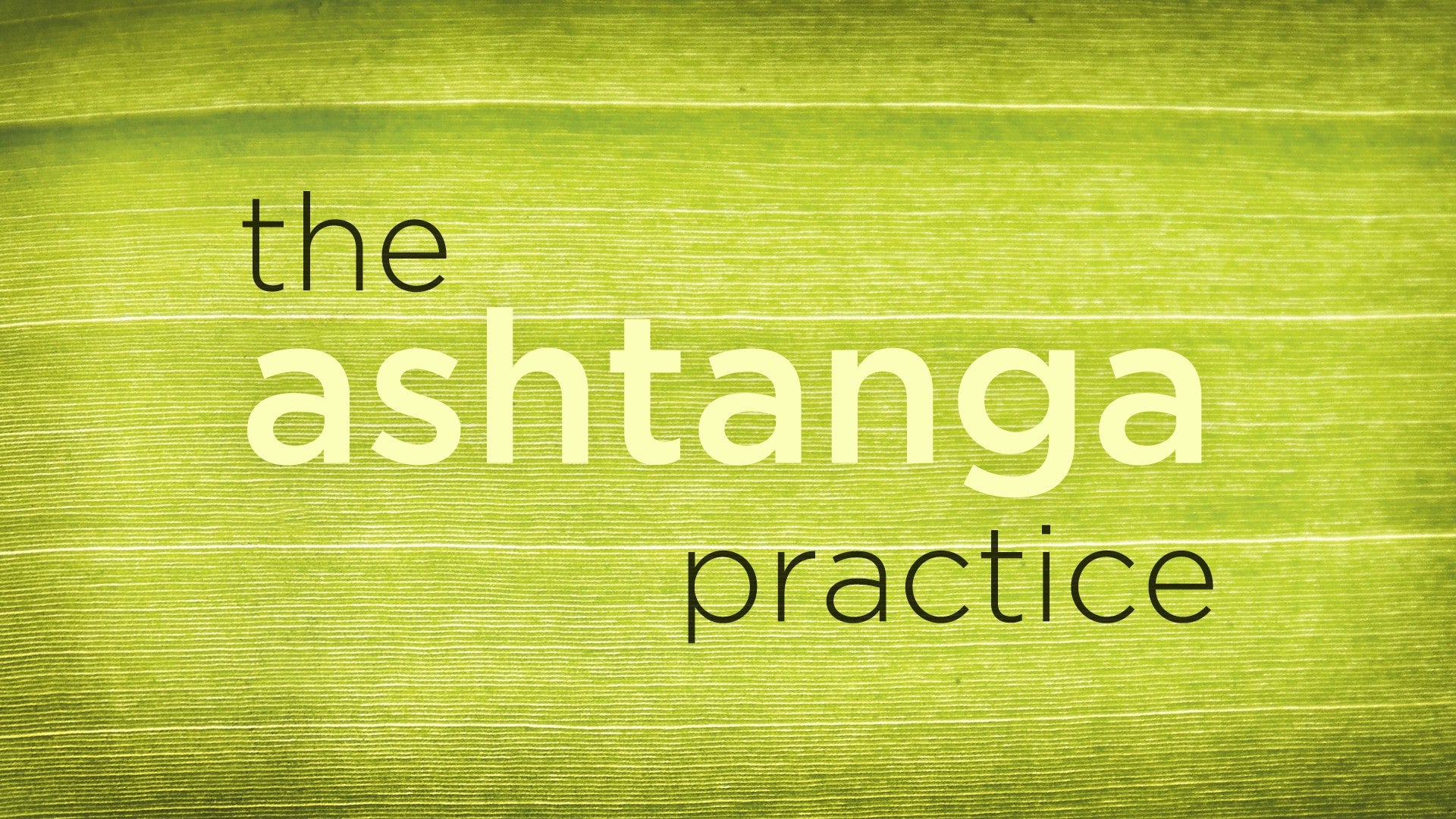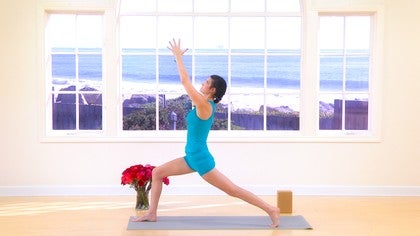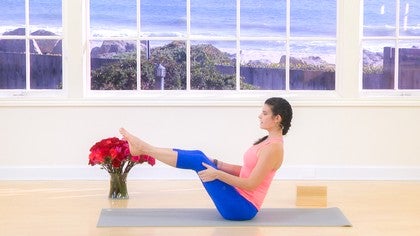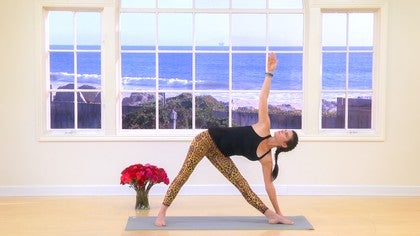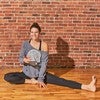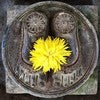Description
About This Video
Transcript
Read Full Transcript
Welcome back. If you joined me earlier, we were talking about the five principles of ashtanga, and in this session we're gonna be practically applying them. So we're gonna talk about and practice the foundation of flow, which is surya namaskar A and surya namaskar B, also known as sun salutations. If you think of ashtanga as a sandwich, what we are doing now is the bread. You can't have a sandwich without the bread.
You cannot do this practice without sun A and sun B. For beginners, it's a lot. Pattabhi Jois and my teacher David Swenson referred to this as the minimum daily prescription. Five A, five B, the last three postures and shavasana. So sometimes your sandwich is a little smaller.
Sometimes your sandwich is really big, in which case, you pack in your condiments. The mayo, the mustard, which would be the standing series, and then the meat, which is, in this case, the primary series, the seated series. And then I guess we're down here, you've got some pickles maybe, which would be the finishing sequence. And then the closing sequence is your last piece of bread. So you have this whole meal, right, and what we're gonna do in these sessions is take little bites of the meal so that you can get the flavor or this practice, and also have some tools in your back pocket so that when you go to a class or when you're practicing at home, and you encounter these postures, you know how to make them fit for you.
It's not a one size fits all practice. So what we're gonna do in sun A and sun B is break down not only the breath but also the push up, which is called chaturanga. The back bend which is upward facing dog, and we'll work a little bit with downward facing dog. But mostly what I want us to really try to feel is the flow. So my breath is different from your breath, but that doesn't mean that we're doing different things.
A lot of people who never do yoga have heard the word mantra. It is a yoga term. Meaning sort of a mind control, something that focuses your thoughts. And as we start to move, I want you to allow the breath to be your mantra. It's the most universal thing.
It's not affiliated with religion, with culture, with language. We all breathe. And what we are trying to do is allow our breath to inform how and when we move. So I'm gonna stand up here at the top of my mat and show you a bit of ujjayi, which we discussed in a previous segment, which is the pranayama we use in ashtanga. And as we start to move into the sun A and sun B I'll be using the block, and I'll show you ways you can modify and change so that it fits for you.
In Samasthiti, which is what we call Tadasana in ashtanga, it's the standing posture. You're not getting your portrait painted. You don't need to be like this. You're also not a supermodel. You don't need to stand like this, like that.
Imagine you are meeting someone you really like, you are going on a job interview, maybe. Shoulders back, chest up. Belly in, remember your bandha. And then relax there for a minute. Feel your feet, wobble your head a bit, get your balance.
And notice the way you're breathing right now. You're not doing anything with it, right? You're just breathing. I want you to keep that in the back of your mind, and then put your hands on your ribs just like this with your thumbs towards the back and hold your ribs in your hands. And then breathe into them.
You should feel, or you probably feel, as you inhale, the ribs pull out away from your spine. And as you exhale, they pull back in. This is the bread and butter, to continue with my food references, of this breath. The horizontal movement away from the spine. The lower belly (slurps) doesn't pump with air.
It's really relaxing to take belly breaths. It feels great, it's not wrong. In this practice, we try really hard not to let the lower belly pump with air like this. We wanna keep breathing here. So just settle in with that just for a moment.
We'll do it together. So now that you're comfortable with that feeling, or you're getting comfortable, I want you to imagine that you're whispering at me. We're doing some breathing exercises. You have to lock your throat. So just like when you whisper, you constrict here, you do the same thing with ujjayi and we always breathe through the nose unless you absolutely have to breathe through your mouth, then breathe through your mouth, please, that's fine.
So, you will sound as though you are snoring, perhaps, or maybe more poetically, since we're at a beach, the sound you would hear when you hold a shell to your ear. It's kind of a hollow snoring quality to the breath. The louder, the better. (breathes deeply) Release your hands but maintain your breath. Continue like this for a few moments and observe, without trying to change, how you feel.
What is the quality of the breath? And if it's not too complicated, take a little bit of your awareness into your lower belly (slurps). And a little bit of awareness to the pelvic floor, mula bandha. And then relax. (breathes out) Breathe naturally.
And notice, it's different. This is a part of the culture. This is a part of the language of this practice. You breathe differently when you do other kinda of yoga. When we're practicing ashtanga, we try very hard to keep that ujjayi pranayama.
Not only does it help reduce your heart rate, because we're gonna start to move a bit, and you might feel a bit like (pants). A nice, long (breathes out slowly) ujjayi breath goes a long way towards settling the heart rate down, but it also makes you sweat. It develops heat in your body, which is another reason why this is a hot practice. You have to build your own heat in this practice. That's what ujjayi is there for.
It's also the rhythm. One breath, one movement. Unless you need to take extra breaths, and then again, please do. So I'm gonna turn this way and I'm gonna go through one round of surya namaskar A once, and then we're gonna work shop it a bit to make it a little bit more accessible. I'm going to cue the breath as I move, so that you can breathe with me and start to get the rhythm for yourself.
But my breath might be longer than yours, it might be shorter than yours. That's okay, it's all fine. It doesn't have to fit into a certain time limit. So at the top of my mat, I'm in my Samasthiti, and before I get started, I wanna go through my check list. Bandhas (slurps) lower belly, pelvic floor, and the lock in my throat which helps me cultivate my breath.
We spoke in an earlier session about sort of a scale of work in the bandhas. Because I'm getting ready to move, I'm not doing anything particularly dynamic. I don't need to do that much work in my bandhas right now, I just want to be aware. So 10 is the highest. I'm like a three or a four.
Chest up, shoulders back, belly in. Eyes open. Inhale, arms up. The gaze is at the thumbs. Exhale, fold forward.
Gaze between your knees. Inhale, halfway up, gazing forward. And exhale, step back, chaturanga, lowering down, gaze forward. Inhale, upward facing dog, looking at the bridge of your nose. Exhale, downward facing dog.
The gaze is between the knees. And we take five breaths here. After my last exhale, inhale forward into the halfway lift. Exhale, fold. Inhale, all the way back up, following the fingers with the eyes.
Exhale. Back to the beginning. How did it go? That's surya namaskar A. There's a lot going on.
So we're gonna slow it down a little bit and we're gonna use our block, or I'm gonna use my block to help me with a couple of things. So let's assume that my hamstrings are tight. Right away, I can help myself out by separating my feet. Because I know I'm gonna fold forward, so when I go forward when my feet are separate, it's a little nicer for the back of the bun. These are my hip creases.
You want to imagine you have chopsticks here and you're gonna hold them when you fold. So as I exhale and leading with my chest. Folding, folding, folding, folding. Here go my chopsticks. And then I'm in my forward bend.
And again, we're assuming that I have tight hamstrings, so. (clicks tongue) Bend your knees. Let the head relax. You're looking forward, you're putting strain on your neck. It feels terrible.
Look this way. Your gaze is between the knees. And then inhale, we're coming halfway up. So I've got tight hamstrings, keep my knees bent. I can either put my hands here, roll the shoulders back, look forward (slurps), belly in.
Breathe. Or, let's say I've got a block. I can make the floor this much higher, which is also nice. Shoulders are back. Belly is in.
And your weight is a little bit forward. So often... Now, I'm flexible, so what's easy for me to do is to lean back in the forward bend. Roll your weight forward as though you are going to tip. And then the work is to not tip.
So I'm in my Samasthiti with my feet separated because I know my hamstrings are tight and I wanna be nice to myself, so I just take the slightly wider step. Just one fist between your feet, that should do the trick. You'll know. And then come back into your posture. Inhale, arms up.
Exhale, fold with the knees bent. Look between your knees. You can bend then as deeply as you need to to feel relaxed. Inhale, palms press into the shins, lift halfway up. As you're lifting halfway up, pull your shoulder blades back in the direction of your ribs (slurps).
Belly in. For those of you that are not dealing with tight hamstrings, straighten the legs. You can still be up here with me, or, fingers on the floor, palms on the floor, or maybe your hands are still back here. The gaze is forward, the shoulders are back. Belly's in.
Breath is across the ribs. So this is one inhale, we're looking forward. Now I've got tight hamstrings so I'm gonna keep my knees bent, and maybe if I'm in a studio or practicing with props, I bring the floor a little closer to me. This is also fun. You don't wanna be like hanging out like this.
We're still staying in shape here. And then just move it out of the way, because we're gonna put the palms on the floor and step back into plank. So let's take a beat in plank. Situate yourself. Give yourself a little bounce.
See where your weight is. For most people, especially beginners, you're gonna have a lot of weight in your upper body. It's gonna be like (sighs), like this. Pull the shoulders back like we did before, lift a little more in your hips, more than you think you have to so that your belly button goes (slurps) in. And then, find your ujjayi breath.
Take your knees to the floor. So we're gonna talk for a minute about corsets, which some of you may have worn. You might be wearing one right now. I don't know. You wanna feel like you have a corset on.
And if you've never worn a corset, it's like this. (slurps) It pulls in and it tightens back here. Right, this is where all the little bits and bobs are, in the back. Your core muscles are like that. We think of the core as like a washboard, right?
Which, it's true, you have your topical muscles here. But when we're doing a posture like chaturanga or plank, we don't really care about the washboard. It looks good and it's useful, but what's more useful are those muscles that feel like a corset, the ones that snuggle in. So these are your triceps, your lats. We're using all of these muscles here.
This is the primary arm muscle we're gonna be using in chaturanga. So when we come back into plank, I want you to pause for a minute and find your ujjayi pranayama. Nice and relaxed. But I want you to look for that snuggling feeling in the core. And then I want you to, and this is asking a lot, so you can put your knees on the floor as well, but I want you to keep all of that the same.
And then take a little bit of your attention to the belly and just pull it in towards the spine, so you're going to feel like you are over correcting your lower back, like this. So it will look like this. That's the top of our push up. Okay? So let's assume that that's fine.
No problems there. I'm gonna show you the push up, the chaturanga. And then we're gonna talk about ways to make it easier. It moves into a back bend, toes touch the floor. The sternum lifts, the hips lift, the belly lifts, the gaze lifts.
And then we roll back into dog, but before we get there... Oops. We're gonna do a little measuring. So you may not have a block. That's okay, you can just look at me and you'll kind of know what's gonna be appropriate for you.
This is the highest speed of the block, it's the top. I'm gonna put it here in my sternum. So this is where I want it to be when I'm on the floor. I don't wanna squish myself into it. It's just for reference.
It's gonna go here. So when I'm in a chaturanga, my sternum is here, my shoulders are here, hips back here. One line. More or less. Sometimes it's like (clicks tongue).
Like that, that's okay. We're aiming for one long line. There's a lot of ways of teaching chaturanga and practicing chaturanga. The way that you're doing it or the way that you've been taught is probably not wrong. It's probably totally, totally fine.
This is just one way of experiencing this. It's a push up. You don't have to be that strong. I'm not. You just have to know how to redistribute your weight.
So this block is gonna help us. So I'm gonna come into my plank and get everything sorted out. Now I'm flexible, right? My elbows can pop out a bit like that. Little baby bend.
And as you're doing that little baby bend, it helps you find that work of the shoulders pulling back. So again, chopsticks in your armpits. I live in China, so there's a lot of chopstick references when I'm teaching. Or maybe I'm just hungry, I don't know. So pulling the shoulder blades back, looking forward, cuz I'm trying to go forward, right?
I'm using my legs. This is where that weight distribution comes into play. So I think this might be a little bit far back from where I'm trying to go. You can kind of test by here. Okay?
So, plank. On an exhale, chaturanga. Inhale, knock your block out of the way, upward facing dog. Exhale, down dog. So (chuckles), sometimes when you do that, you have to kind of lower down, and then (groans).
Move it out of the way. That's okay. Takes a little bit of time. For me, that's probably good. This is the height that I wanna be, chest to floor.
Some people will be here. Some people will be here. Some people will have smaller blocks and they'll be here. It's all fine. The most important thing...
Shoulders away from the ears. Shoulders and pelvis in the same line. And your breath. If you're doing the chaturanga, and it looks like this. (sighs) Like that.
It's not gonna be fun. You're not getting anything out of it, except maybe a little bit sweaty. So I really encourage you to take the time to figure out what is the right chaturanga for you, because everybody's different. And you're different on different days. Some days I'm stronger, some days I'm not.
And on days when I'm not, here's what I do. You notice the difference? My hips are on the floor, my thighs are on the floor, but I'm still in my back bend. And then I roll back onto my knees, tuck the toes and find a dog. So those are a couple of ways to modify your chaturanga.
I really encourage you to find the right spots, the right place for you today. And then notice if it's different tomorrow or the next time you practice. And if you're doing a full primary practice, or you're in a vinyasa class, mix and match, because one's gonna feel great, one's gonna feel less great. But you're gonna learn from both. So if you're in a studio, just take a second, find that block.
You're pushing it forward to get that lift of the chest in upward facing dog. Which we'll talk about now. So upward facing dog is... It's an asana in itself. It often gets sort of overlooked because there's so much emphasis on that push up, like you really muscle your way into the push up and then quick inhale, up dog, and then you go into the downward facing dog where you get five long luxurious breaths.
Can't wait to get there. I get it. But let's take a little bit of time to get some love to our upward facing dog. So I'm gonna sit for a moment. Take your fingers to your sternum.
Just like this. And then lift up. So this feeling of the lift is really crucial to the upward facing dog. If you don't do anything else with your hips, your gaze, I want you to try to move your breath bone, the hard part of your chest forward and up. And then as you do that, what's natural is for people to take the shoulders with them like this.
Now, think about when you're getting your picture taken. What looks good? This? Or this? This is much nicer, right?
Much, much nicer. Shoulders back, chest up. (slurps) Belly in. So I'm gonna show you my upward facing dog. I'm coming here, and all of my little toes are pushing into the floor.
My shoulders are forward. I'm gonna pull them back. As I lift up into my belly, lift the chest, lift the gaze. I should be able to go side to side. And if you can hear in my voice, it's a little bit hard to breathe here, that's okay.
Just be patient. And exhale, roll over your toes into down dog. That's a lot. It's a very dynamic posture. Let's assume that I have back problems.
My upper body's a little weak. I don't really know what's going on in my core. My spine maybe is little inflexible. Let's assume all of those things. So what would I do?
I would find my chaturanga. And probably, in that case, I'm gonna bend my knees. Inch worm down, chin and chest towards the floor. And then I move into my cobra. Shoulders back, lower belly in, sternum lifts.
Photogenic. In this instance, your drishti is straight ahead. If you look up in your cobra, you might put too much strain on the neck, so just keep your gaze straight ahead like that. Then you roll back into your downward facing dog. That is one way.
The teacher will continue to cue, "Inhale up dog." You continue to do your cobra. That's okay. As long as you are flowing with your breath. As long as you are in control of the breath and the bandhas, you are doing your practice, you're doing your back bend, you're doing your push up, it's all good. There's a couple of other ways to modify upward facing dog.
And the other one is to come down all the way. Slide the hands back a little bit. Spiral the thighs. Get those toes pushed into the floor. And peel up and then lift.
Roll back. I like that way. But if you're in a traditional led ashtanga class, you may not have time for that. So we've looked at one way to modify your upward facing dog, and I'm gonna show you another way, which you, if you are in a traditional led ashtanga class, you may not have time for this, but it's a really nice one to try at home or before your practice, or even during your practice if that's what feels right for you. So I'm gonna start on my chaturanga.
Lowering down. All the way to the floor. And I spiral the thighs in a little bit. All my little toes are on the floor. Pull the navel in towards the spine, and then slide my hands back and peel up into my up dog.
And then exhale, rolling back. Downward facing dog. So just to refresh, we have option one. Lowering down, inhale, pushing up. Exhale, downward facing dog.
Option two, you take the knees to the floor. And you move into a cobra. Downward facing dog. Option three. All the way down.
Lifting up. Downward facing dog. Here's another option. I find my plank. I've stepped back on an exhale.
I inhale. And I exhale, down dog. And everyone else does push ups. That is a really good option that I use a lot, to be honest, because the most important thing is that you are able to breathe, that you are comfortable in your body with your breath, and you're not stressed out. I don't want you to worry about the alignment of your elbow over your wrist and feeling the navel pulling in and over correcting in the lower back if you can't connect with your breath.
So that's what's really important. So I love to use that last option. I love to teach that last option. And I would love for you to use it as long as you're breathing. Other teachers may tell you differently.
They're not wrong. This is just an option. It's something that you might like. So that's basically surya namaskar A. With the chaturanga and the upward facing dog.
The downward facing dog is a little bit different. We're not gonna use this anymore so I'm gonna move it back here. When we're in downward facing dog traditionally in ashtanga, you don't walk your dog. There's not this. Wiggling, wobbling, getting comfortable.
What happens is you simply move into your dog on an exhale, and you set your heels back down towards the floor, you lift up through the crease of the hips and you breathe. (exhales deeply) Easy enough, right? So let's assume that it's not easy at all. And it's not. When you are upside down, your exhale is easier.
It's just (breathes deeply). It comes naturally when you're upside down. So really take advantage of that. Use it as a rest break. We don't have to do anything else in the downward facing dog, we're just there to stretch and look for spaciousness and cultivate the breath.
Some people might be doing handstands around you, just stay with your breath. So I'm gonna show you one way to do downward facing dog. And again, now I've got tight hamstrings. So just like I did in my halfway lift, (clicks tongue) bend your knees. So your butt sticks up a little bit, that's okay.
No one's looking at you. Draw in with the belly. Push the shoulders down towards the ribs. And breathe. At some point maybe your heels will move toward the floor.
But if they never do, that's fine. Some people have very short dogs, some people have very long dogs. You're gonna know what's best because you'll feel comfortable, you'll have spaciousness in the spine, you'll feel a nice stretch in the back of your legs. Shoulders broad. And your biceps.
So when you're in your dog, you can kind of look left to right and just see that they are moving away from you. The eyes of your elbows are looking towards one another, and then all your knuckles push into the floor, so it's like you kind of have paws. You have spongey hands. So that's your dog, okay. Five breaths.
Let's imagine that I have really tight shoulders and I might be in this sort of interim space between a plank and a dog. Which happens. I can turn my hands out like this, which will give me just a little bit more space to push back up into the hips. If I'm bored in my dog, you can turn your hands in and try to do the same thing. But if you're bored in your dog, you're not thinking about your breath.
So inhale into the ribs. Exhale, ribs pull in. That's what happens in your dog, okay? So you can fiddle with different stuff, but I want you to really emphasize your breath. So after that, I've done five breaths.
On my exhale, I prepare to come forward. Inhale, stepping up into one big breath. Halfway. And then I'm back in my forward fold. Inhale, I'm coming back up.
That's surya namaskar A. So those were some tools you can use in your surya namaskar A. I'm now gonna lead you through two rounds. I'll cue the breath and I'll give a little bit of instruction, but I really want you to try to apply what you've already practiced to this movement, to this sequence. So coming to the top of your mat.
Finding Samasthiti, however that looks for you. Inhale, arms up. Exhale, fold forward. However that looks for you. Inhale, halfway up.
Exhale, chaturanga. Inhale, upward facing dog. Exhale, down dog. Five breaths. One.
Two. Three. Four. Five. Inhale, step forward.
Lift halfway. Exhale, fold. Inhale, all the way up, palms touch. Exhale, Samasthiti. One more round.
Inhale, arms up. Exhale, fold. Inhale, halfway. Exhale, chaturanga. Inhale, up dog.
Exhale, downward facing dog. One. Two. Three. Four.
Five. Inhale, step up. Lift. Exhale, fold. Inhale, all the way back up.
Exhale. Samasthiti. Traditionally, you do that five times before you move into namaskar B. We're gonna skip ahead a bit and move into our B. Which is more or less the same, but with three new things.
I'll do one round by myself. And then we'll do a few together. Inhaling, sitting back. Exhale, fold. Inhale, halfway up.
Exhale, chaturanga. Inhale, upward facing dog. Exhale, down dog. Right foot forward. Inhale, Virabhadrasana A.
Exhale, chaturanga. Inhale, up dog. Exhale, down dog. Left foot forward. Inhale.
Exhale. Inhale. Exhale. One. Two.
Three. Four. Five. Inhale. Halfway.
Exhale, fold. Inhale, sitting back. Samasthiti. So you may have noticed there are many things that were the same. The forward bend, the halfway lift, the chaturanga, the up dog, the down dog, the forward bend, the halfway lift, and Samasthiti.
Three new things in namaskar B. Utkatasana, or as we call it in ashtanga, inhale, sit back. And warrior one, Virabhadrasana A. So we're gonna talk a little bit about warrior one. Because there's a lot going on and we do it very quickly.
So before you get to that space of finding the flow, finding the rhythm, it's helpful to know what you're doing. So when I'm in my warrior one... In ashtanga, you may have noticed. Well, you probably haven't noticed. That was the first one we did.
But we always do the right side first. So my right leg is my starter leg. So I'm stepping back and I want my hip points to look straight ahead. However, my knees are the boss of that, so if my hip points can't turn forward without my back knee really cranking or tweaking or causing problems or the front knee is saying something to me, maybe I take a wider step. Taking up more space on the mat.
Or, I turn the back heel up away from the floor so both hips naturally point forward. This is a little more accessible for more people, especially for newbies. It's not traditional in ashtanga. Doesn't mean you can't do it, it just means your teacher will cue something else. You have to know what's right for you, which is why I'm giving you this option.
So if your back heel is lifted, you're lifting up our of the waist. Shoulders are down and back. Gaze is at the thumbs. Oops (chuckles). That's your warrior one.
If your back foot is angled, it's at about 45 degrees. And then the hips turn. Lower belly (slurps) towards the spine. Reaching up. Shoulders down and back.
My drishti is at my thumbs and I'm using my shoulder blades to pull down to lift in my chest. That's Vira one. So we all can probably do that. Just stepping into it. Right, you can do some variation.
It gets a little trickier when you have to come into it from downward facing dog. Here's some ways to make it easier. Take an extra breath. Inhale, one leg up. Exhale, curl that leg up.
Pivot the back foot. Move the feet in opposite ways. Inhale up. Vira one. Here's another way.
Inhale up. This leg may not be as smart as the other one. It doesn't go as high. That's okay. Curl, curl, curl, curl.
And maybe it just gets here. Pick it up. Put it at the top of your mat, and then set yourself up. Coming up. Warrior one.
Or you're in a high lunge with the back heel lifted. Your knees are the boss, so you have to be very careful to decide if you're gonna have that back foot at an angle. Your back knee is gonna tell you if it's okay. I don't know. Only you do.
The lower belly goes (slurps) in. Hip points are moving forward. There's a nice space in the side of the body to find your warrior. That's the standing section utkatasana. Pretty self-explanatory.
There's a chair back here. It's a weird chair. Not a normal one. You're sitting back, back, back, back, back. Touch the floor, draw in with the belly.
Inhale, biceps up along side your ears. Pull the shoulders back. Gaze at your thumbs. Exhale. Samasthiti.
So if you can tell (chuckles), you can hear from the sound of my voice, it's hard. There's a lot going on. We're gonna move through it a few times. One breath, one movement. If you need to take extra breaths, that's fine.
I probably will. And I will modify as we go so that you can see what your options are. So coming back up to the top of the mat. Finding your Samasthiti. Surya namaskar B.
Inhale, sit back. Exhale, fold. Inhale, halfway. Exhale, chaturanga. Inhale, up dog.
Exhale, down dog. Right foot forward. Inhale. Exhale. Exhale to dog.
Left foot forward. Exhale to chaturanga. Inhale, up dog. Exhale, downward facing dog. Inhaling forward.
Exhale, fold. Inhaling, sit back. Exhale. Samasthiti. We'll do one more together.
I'll practice with you and I'll cue the breath. Try to find your own rhythm. Beginning on an inhale, sitting back. Surya namaskar B. Also, five times, a minimum daily prescription will be five A and three B or three A, two B.
It's a lot. Take your time with it. Try to enjoy it. Find a rhythm of your own breath. What I'm doing doesn't necessarily matter to what you're doing.
You might look totally different. Your breath is different from mine. Take your time and really feel it. Thank you.
The Ashtanga Practice: Sarah Lowe
Comments
You need to be a subscriber to post a comment.
Please Log In or Create an Account to start your free trial.
